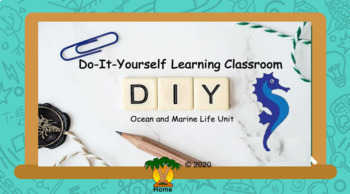Ocean and Marine Life K-6 Independent Learning Unit
- Google Slides™
- Internet Activities

Description
**I have updated this asynchronous unit, adding many resources and more slides and deleting bad links***
This is a self-guided iIndependent learning unit for students in grades Kindergarten through 6th grade on the ocean. 25 slides with many resources, including some resources in Spanish. books, videos, music, art, games, quizzes, webcams, puzzles, virtual field trips, careers, research websites, writing websites. Very useful for using with students when teacher is absent or Internet is down. Also a useful homeschool resource.
I know from my own experiences over the past month....teaching kids in kindergarten through 5th grade online is HARD!!
In addition to the typical pedagogical challenges of teaching remotely, students and teachers face daily challenges with technology: Internet dropping, lack of wifi, slow connection speeds, etc.
After my Internet suddenly dropped and I disappeared right in front of my students' eyes, I decided to create an asynchronous unit full of activities and resources that students can easily access on their own. You can use these in your regular program or as a resource for students to access when and if you can't be with them virtually.
This first unit is on the ocean. Feel free to make your own copy to edit and make any changes you like in Google Slides or Powerpoint.
I will be working on the next Asynchronous Online Unit on the Solar System and Space Travel





